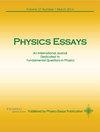通过将光定律应用于物质来测试普朗克尺度的机制:一种与标准理论非常相似的新引力理论
IF 0.5
Q4 PHYSICS, MULTIDISCIPLINARY
引用次数: 0
摘要
普朗克尺度被认为是我们所知的空间、时间和物质的起点,似乎对物理学至关重要。我们对这个规模的想法还不清楚。弦理论依赖于超对称性,而超对称性出人意料地没有被发现——这并没有留下可靠的画面。在一些观点中,那里的世界是混乱的,很难在更大的范围内解释这种秩序。直接实验无法达到这个规模,但间接实验和数学可以。由于弦论的原因,认为只有复杂的数学才是相关的是错误的。这篇论文是三篇论文中的第二篇,基于概念基础,对空间结构、光和物质的性质进行了一小群简单但横向的假设。它导致了解释,在某些领域导致了重新探索,在另一些领域导致了与现有物理学密切相似的新数学。主要理论的两个分支是维度量子力学[J.M.Kerr,Phys.Essesses 33,1 2019)],以及普朗克尺度引力(PSG),其中引力机制再现了牛顿理论和广义相对论的部分。在一个简单的方法中,其结果本质上是测试小尺度物质与光相似的想法,因为两者都是维度结构中的波,在空间结构中以不同的方向传播,空间结构采用平行圆柱体的形式。如果假设物质以c的速度围绕圆柱体的圆周运动,在普朗克尺度上形成环,这与闭合弦没有什么不同,那么就可以将通常适用于光的定律应用于物质。结果是引力的数学,可以被视为“确凿的证据”(第11页),表明通过引力场的任何轨迹上的每一点都与它上面的每一个点相连。PSG在数学上与GR不同,但它在一系列物理中都模仿了它,在大多数情况下都是小数点后八位。在包括引力波在内的许多领域,它在概念上等同于GR,并在少数地方发散,导致了可测试的预测。本文章由计算机程序翻译,如有差异,请以英文原文为准。
Testing a Planck scale mechanism by applying to matter a law for light: A new gravity theory that closely mimics standard theory
The Planck scale is thought to be where space, time and matter as we know them begin, and seems to be vital to physics. Our ideas about that scale are unclear. String theory is dependent on supersymmetry, which unexpectedly has not been found—this leaves no reliable picture. In
some views the world is chaotic there, making it hard to explain the order at larger scales. Direct experiment cannot reach that scale, but indirect experiment and mathematics can. It would be wrong to assume, because of string theory, that only complex mathematics is relevant. This paper
is the second of three from a conceptual basis with a small group of simple but lateral assumptions about the structure of space, and the nature of light and matter. It leads to interpretations, in some areas to rederivations, in others to new mathematics that closely mimics existing physics.
Two spinoffs from the main theory are dimensional quantum mechanics [J. M. Kerr, Phys. Essays 33, 1 2019)], and here Planck scale gravity (PSG), in which a gravity mechanism reproduces Newtonian theory and parts of general relativity (GR). In a simple approach, the result is essentially
to test the idea that matter at a small scale is similar to light, as both are waves in the fabric of the dimensions, traveling in different directions through the structure of space, which takes the form of parallel cylinders. If one assumes matter travels at c around the circumference
of the cylinders, making loops at the Planck scale not unlike the closed string, one can apply to matter a law normally applied to light. What comes out is the mathematics of gravity, with what might be seen as “smoking gun evidence” (p. 11), showing that every point on any trajectory
through a gravitational field is connected to every other point on it. PSG is mathematically different from GR, but it mimics it across a range of physics, in most cases to eight decimal places. It is conceptually equivalent to GR in many areas including gravitational waves, and diverges in
a few places, leading to testable predictions.
求助全文
通过发布文献求助,成功后即可免费获取论文全文。
去求助
来源期刊

Physics Essays
PHYSICS, MULTIDISCIPLINARY-
自引率
83.30%
发文量
50
审稿时长
6-12 weeks
期刊介绍:
Physics Essays has been established as an international journal dedicated to theoretical and experimental aspects of fundamental problems in Physics and, generally, to the advancement of basic knowledge of Physics. The Journal’s mandate is to publish rigorous and methodological examinations of past, current, and advanced concepts, methods and results in physics research. Physics Essays dedicates itself to the publication of stimulating exploratory, and original papers in a variety of physics disciplines, such as spectroscopy, quantum mechanics, particle physics, electromagnetic theory, astrophysics, space physics, mathematical methods in physics, plasma physics, philosophical aspects of physics, chemical physics, and relativity.
 求助内容:
求助内容: 应助结果提醒方式:
应助结果提醒方式:


